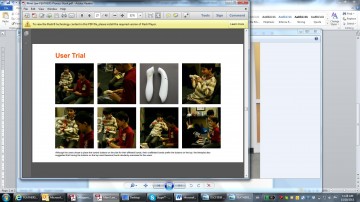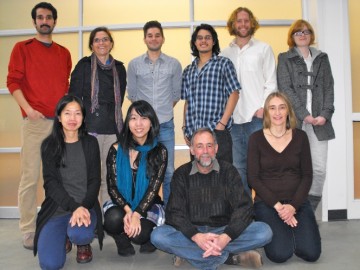FEATHERS: Functional Engagement in Assisted Therapy through Exercise Robotics
A unique collaboration between interdisciplinary researchers, clinicians, decision-makers and patients and their families, this project brings together (1) UBC research leaders and graduate students from Mechanical Engineering, Physical Therapy, Occupational Science and Occupational Therapy, and Kinesiology and (2) decision-makers, therapists and patients/families from two community rehabilitation centers – BC Center for Ability and Abilities Neurological Rehabilitation (refer to the list of participants at the end of this document). The funding for this research is provided by the Peter Wall Solutions Initiative – a Vancouver grant program enabling UBC researchers in all disciplines to engage community partners to develop practical solutions for societal problems.
The objective of FEATHERS is to develop social gaming programs, supported by upper-limb robotics, that will enable and motivate children with cerebral palsy, and older adults after stroke. These programs will motivate participants to practice, with greater frequency, their bilateral upper extremity home exercises. The impetus is the mounting evidence that although intensive repetitive therapy is required to stimulate neuroplastic changes in the motor control system most patients do not undertake a sufficient number of repetitions of these tasks in their therapy or home training sessions. The focus on bilateral tasks is based on evidence from electrophysiological studies demonstrating that bimanual training also elicits activity in the damaged ipsilateral hemisphere. The addition of the robotics is to enable the task to be as precise as possible. The use of the online gaming environment recognizes the advantages of social interactions in terms of cooperative learning, i.e., learning through monitoring another person’s actions/errors can result in similar neural activity as when learning through one’s own mistakes. Moreover, engaging socially has been shown to enhance motivation to participate, and thus there is the opportunity to track performance through a Facebook ‘group’. Finally, the results of this type of home therapy can be monitored by therapists to provide outcome measures to evaluate changes in performance.
Undertaken focus groups with OTs and PTs to identify:
- Barriers to use, e.g., age appropriateness
- Current technology use, e.g., family resources
- Benefits of future use, e.g., motivators, peer pressure
- Desired features of the system, e.g., sensory feedback to a child
- Context, e.g., fitting in with friends and family
Developed preliminary versions of:
- Software for bimanual cursor control
- Software for sharing of social media scores from on-line games
- Hardware for disability-appropriate orthoses
- Conceptual design
Testing of powered orthoses
Submission of manuscripts:
- Verster, A., Shirzad, N., Technical design decision report on controllers, social media, and software platforms for FEATHERS, July 2012.
- Law, M., Hay, J., Controller design concept alternatives, Design Review presentation to the ECUAD 4th-year capstone Industrial Design Course, Oct. 2012.
- Tatla S., et al., The impact of motivation on rehabilitation outcomes in children with brain injuries: A systematic review, submitted for journal publication Oct. 2012.
- Lohse K., et al. The role of gaming and motivation in promoting successful therapy, submitted for journal publication Dec. 2012.
Clearly, a great deal has been accomplished, and the team is focusing on these goals for 2013:
- Focus groups with patients/families to identify barriers and needs
- Development of prototype devices and systems
- Testing of devices and systems in clinics
- Focus groups with therapists, patients and families regarding their feedback on devices and systems
Team members:
Dr. Mike Van der Loos, Mechanical Engineering, Principal Investigator
Dr. Elizabeth Croft, Mechanical Engineering
Dr. Lara Boyd, Physical Therapy
Dr. Naznin Virji-Babul, Physical Therapy
Dr. Nicola Hodges, Kinesiology
Dr. Linda Li, Physical Therapy
Dr. Liisa Holsti, Occupational Science and Occupational Therapy
Dr. Keith Lohse, Post-doctoral fellow , Kinesiology
Navid Shirzad, MASc student, CARIS Lab: study design and human-robot interaction
Alida Verster, undergraduate student: game interface and social media programmer
Sandy Tatla, Master’s student in OSOT: children with brain injuries
Mel Lam, PhD Student, Kinesiology: motor Learning, focus group data analysis
Bulmaro Valdés, PhD student: stroke therapy device design
Tina Hung, MASc student: mechatronics design
Alyssa Dunn, Arnold Yeung: undergraduate research assistant support
Mimi Law, Justin Hay, ECUAD design students: orthosis design
BC Center for Ability – Judit Spence: therapy colleagues and patients/families
Abilities Neurological Rehabilitation – Heather Branscombe: therapy colleagues and patients/families
What is the FEATHERS project?
FEATHERS = Functional Engagement in Assisted Therapy through Exercise Robotics
FEATHERS is a unique collaboration of researchers, physiotherapists, occupational therapists with patients and their families.
The objective of FEATHERS is to develop exercise technologies that utilize social gaming and are supported by robotics to help children with cerebral palsy and older adults after stroke to practice their bilateral upper extremity home exercises.
The impetus for this project is the mounting evidence that:
- most patients do not undertake sufficient number of repetitions of tasks in therapy or home exercise to adequately stimulate neuroplastic changes in the motor control system
- electrophysiological studies demonstrate that bimanual training elicits activity in the damaged ipsilateral hemisphere
- the addition of robotics facilitates precision in quantifying the performance of the task
- the use of an online gaming environment enhances motivation to participate and provides opportunity to track improvement
What has been accomplished?
- Focus groups with OTs, PTs, and patients/families have identified: current use, benefits and barriers to use of technology, desired features, and critical issues to consider for application in the therapeutic setting
- Preliminary versions of the software and hardware have been developed. These have been piloted with OTs and PTs and will soon be piloted with patients.
What is next?
The results from the pilot tests will enable the team to modify the software and hardware so as to better meet the needs of therapists and patients.
Where to find more information about this project
More detailed information about this project is provided by the following resources:
- Video: http://www.youtube.com/watch?v=-3l0VpOjMmo
- Webpage http://caris.mech.ubc.ca/research/research-areas/therapy-robotics/
- Contact: Dr. Mike Van der Loos @ vdl@mech.ubc.ca or phone: 604-827-4479

